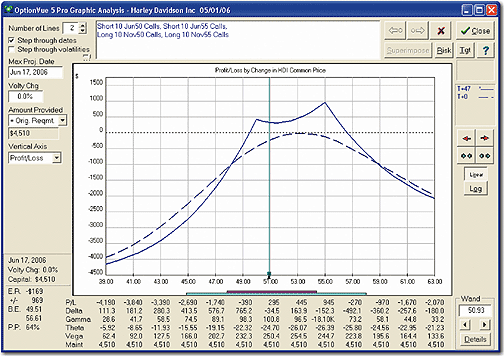Strategies From Trader Dan (Part 2)
Double Calendars And Condors
In this, the second part of a series based on an option seminar with trader Dan Sheridan, we look at the double calendar and condor strategies.
With a stock at 50, an option strategist could put on a call calendar at 55 and a put calendar at 45, short June, long November, hence creating a "double calendar." Is this a good vehicle? Trader Dan Sheridan is ambivalent: "I'd rather put the calendar right at 50 and make the stock prove it's going to move, and then adjust by putting on another calendar at a higher or lower level."
A "better" double calendar, in Sheridan's opinion, is an adjusted single calendar. If the stock moves up to 55, sell the July 55 calls, buy the November 55 calls. The risk curve changes to look like the chart in Figure 1.
DOUBLE CALENDARS
Double calendars work best in a low-volatility environment. (Double diagonals work in both low- and high-volatility environments.) If the strategist turns bullish, a calendar can also be adjusted into a diagonal. In the case study used as an example in this article, with Hdi moving up to 50.93, a strategist adjusts by selling his June 50 call and buying the November 50 call, while staying short the June 55 call (Figure 2). This forces the stock to move to 55 before profit decline sets in. The risk curve then looks like what you see in Figure 3.
CONDORS
An iron condor is two credit spreads, a call credit spread above the market and a put credit spread below. (A credit spread is where you buy one option and sell another, and receive money or a "credit." A debit spread is where you buy one option and sell another and pay money to do it.)
Other condors can be constructed of just puts or just calls, but mixing calls and puts makes this one an "iron" condor. The risk is limited to the amount between the two strikes, typically 10 points minus the credit received.
But do you have to suffer the full 10-point loss after you get your
credit, typically $1 to $1.50? No, you can adjust during the trade. As
Sheridan says, "Doesn't matter what happens in the market, if you have
a plan, you'll be fine."

FIGURE 1: DOUBLE CALENDAR. Here you see the risk curve of an adjusted single calendar, which can provide better results than the traditional double calendar.
...Continued in the June issue of Technical Analysis of STOCKS
& COMMODITIES
Excerpted from an article originally published in the June 2007 issue
of Technical Analysis of
STOCKS & COMMODITIES magazine. All rights reserved. © Copyright
2007, Technical Analysis, Inc.
Return to June 2007 Contents